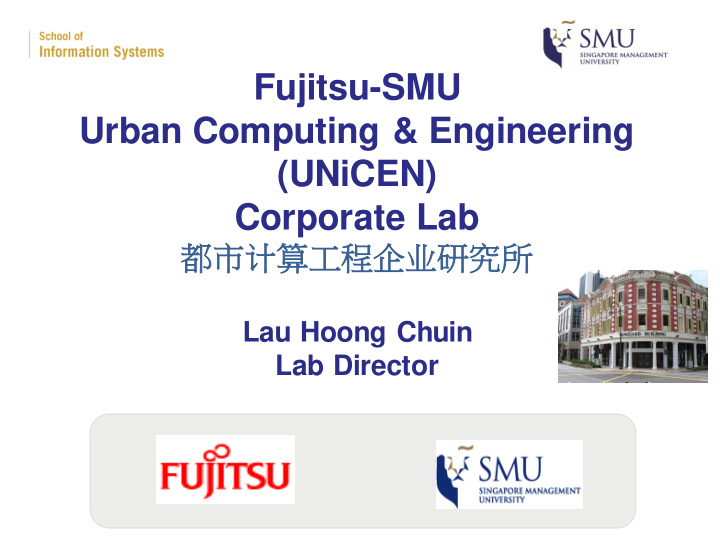



Fujitsu-SMU Urban Computing & Engineering (UNiCEN) Corporate Lab 都市计算工程企业研究所 Lau Hoong Chuin Lab Director
Overview of UNiCEN Part of the Fujitsu-ASTAR-SMU Centre of Excellence (CoE) in Urban Computing & Engineering • Established on 15 Oct 2014 • Objectives – Joint capabilities in data analytics and computing to meet urban and urban- related social needs – Public-private partnership involving A*STAR, SMU and Fujitsu – Develop solutions to address local urban challenges and conduct test-bedding in Singapore for future Fujitsu capabilities and commercial solutions Straits Times, Oct 16 2014
Overview of UNiCEN • Funded by Fujitsu Ltd and the Singapore National Research Foundation (NRF) • Mission : To develop methods and tools for managing resources in crowded cities or urban spaces with sudden buildup of crowds and freight – “Adding Capacity without Building Capacity” • Test-bedding in real-world settings with partners in Singapore and Japan • From sense making to decision making
Research Areas (Phase 1) • Dynamic Mobility and Flow Management (DMM) • Maritime, Port and Logistics Optimization (MPO)
Dynamic Mobility and Flow Management: Conceptual Overview Real-time prediction of demand and supply Train Taxi Bus Taxi Shared Walk Walk Bus Walk Taxi Traveller Shared with Smart Leisure locations and Malls phone large events People Flow and Flexible Mobility on Demand Crowd Management • T o understand and improve people mobility and experience in large urban spaces, especially under extreme conditions and surges • T o develop methods and a new service platform, combining research in data and decision analytics, modeling and simulation, and behavioral modeling, mechanism designs and experimentation
Dynamic Mobility and Flow Management: Research Overview DMM Dynamic mobility & flow management Dynamic Simultaneous Demand & Supply Mass & Personal Matching Flow Control Improving public transport (taxi, flexible MOD) For large urban spaces • City-wide • Ingress and egress of urban space • Specific large crowd location • Flow and experience within public space Schedule Demand Flexible Recommendation / Guidance … Applications estimation optimization transportation / Information dissemination … Data Real-time position Taxi Coupon Real-time ez-link (human, taxi,…) booking tracking tap data Common application / data platform
Dynamic Mobility and Flow Management: Research Perspective • Large-scale multi-agent planning, applied to crowd coordination and dispersion in dynamic/uncertain environments • Integrated sense and response – Operational/Real-time analytics: identify patterns, anticipate irregular demand surges, detect imbalance in mobility demands and supplies – Decision making: take into account predictions based on real-time and historical analytics, and produce plans and schedules for individual travelers and enterprise resources • Address extreme demand scenarios, using existing infrastructure designed for steady-state demand
Dynamic Demand and Supply Matching (of Taxis) • Movement recommendation for taxi drivers – Goals: Improve taxi availability for customers, improve number of jobs/revenue for taxi drivers – When to move? – Where to move? – How to provide decision support to drivers? • Design of incentives & mechanisms for the fleet – Goals: Better serving remote locations, hiring and retaining taxi drivers – What kinds of mechanisms? – What kinds of incentives?
Simultaneous Mass and Personal Flow Control • Ingress: – Parking – Wayfinding • Egress: – Crowd management through to guidance to the right transport mode so as to maximize the disperse rate • Ride-sharing • Post-event/Emergency shuttle buses bridging • Flow within facility: – Agent-based simulation of crowds – Personalized planning of activities and recommendation for shopping and F&B
Research Areas (Phase 1) • Dynamic Mobility and Flow Management (DMM) • Maritime, Port and Logistics Optimization (MPO)
Maritime, Port and Logistics Optimization: Conceptual Overview Ocean – Ships Develop innovative solutions for - Incidents - Congestion in managing the problems across sea lane the Ocean-to-Cities Ecosystem with the foci on enhancing Ports – Yards safety, efficiency, and Ocean-to- - Dynamics - Queuing Cities productivity - Long turnaround Ecosystem time – Study and understand problems of Urban Cities efficiency and safety Warehouses - Space, manpower – Develop new algorithms, models limitations Roads and an integrated platform - Congestion - Empty Trucks 11
Maritime, Port and Logistics Optimization: Research Perspective • Maritime – Modeling and simulation for safer and efficient navigation of maritime traffic – Intelligent coordination of maritime traffic • Port – System dynamics modeling in a port to understand the impact and influencing factors, recommendation for operation decision making – What- if’ scenarios simulation for traffic optimisation and planning • Logistics – Matching of shippers and carriers through market mechanisms to optimize last mile logistics
Questions and Comments • For more information, visit http://unicen.smu.edu.sg/ • Contact hclau@smu.edu.sg unicen@smu.edu.sg
Recommend
More recommend